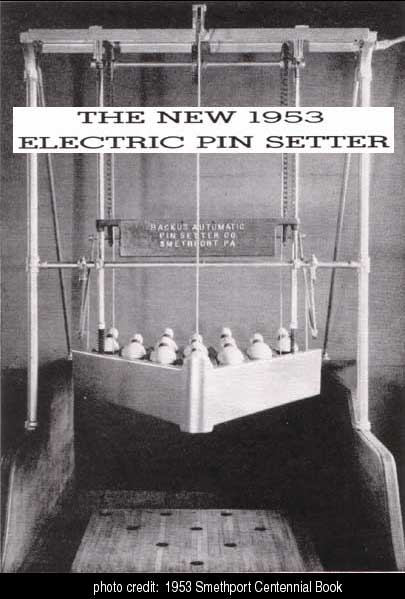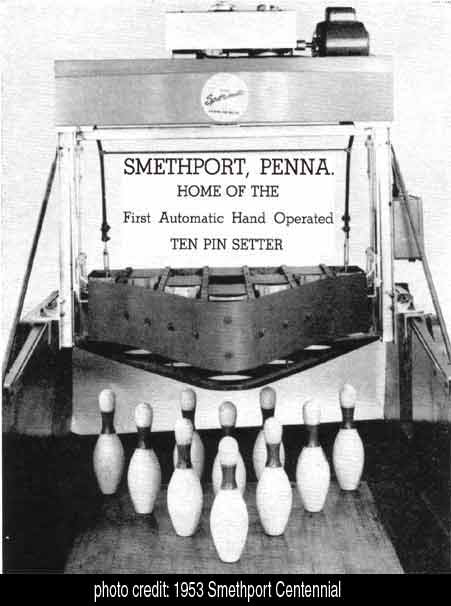PATENT GRANTED SMETHPORT MAN'S PIN-SETTING INVENTION
TWO YEARS AFTER HIS DEATH
Word was received here this week that a patent on a "Power-Operated
Semi-Automatic Pin-setting Machine," manufactured by the Holmes and Gilfillan
Company of Smethport, and invented by the late Milton H. Wright of Smethport,
has finally been granted in Washington, D.C. The patent was granted August 28,
1951.
 The
late Mr. Wright had worked on the perfection of his semi-automatic device, an
improvement on the original bowling alley pin-setting machine invented by the
late J. Clayton Backus
of Smethport, for more than five years, and many attributed his untimely death
in 1949 to overwork and worry over the machine. Mr. Wright died of a cerebral
hemorrage on March 19, 1949.
The
late Mr. Wright had worked on the perfection of his semi-automatic device, an
improvement on the original bowling alley pin-setting machine invented by the
late J. Clayton Backus
of Smethport, for more than five years, and many attributed his untimely death
in 1949 to overwork and worry over the machine. Mr. Wright died of a cerebral
hemorrage on March 19, 1949.
The late Mr. Wright began work on his device back in 1944. He worked on it
about two years and then set it aside for two more years, finally perfecting
it in 1949, when he applied for a patent. Mr. Wright's invention converted the
pin-setting machine known as the "Backus Spot-o-matic" into an electrically
operated semi-automatic machine. It had previously been manually operated.
Mr. Wright sold the rights to his invention, on a royalty
basis, to the
Holmes and Gilfillan company, who
have been producing the machine in large numbers for the past three years. The
machines have been produced on a patent pending permit granted to the company
with royalties accruing to the inventor's widow, Mrs. Milton M. Wright of Marvin
St.
The late Mr. Wright was employed by Holmes and Gilfillan
for over 26 years, starting to work for them in 1923 when he was only 21 years
of age. He was born in Smethport, the son of Mr. and the late Mrs. William Wright,
and he lived in Smethport all his life. At the time of his death he was superintendent
in charge of production of the automatic pin-setting machine he had helped to
perfect at Holmes and Gilfillan.
The elecric pin-setters are today in use all over the United
States and in several foreign and South American countries. One of the first
machines produced to operate electrically was installed in the local bowling
alleys in Smethport, and Mr. Wright frequently visited the alleys to study and
perfect his invention prior to his death.

 The
late Mr. Wright had worked on the perfection of his semi-automatic device, an
improvement on the original bowling alley pin-setting machine invented by the
late J. Clayton Backus
of Smethport, for more than five years, and many attributed his untimely death
in 1949 to overwork and worry over the machine. Mr. Wright died of a cerebral
hemorrage on March 19, 1949.
The
late Mr. Wright had worked on the perfection of his semi-automatic device, an
improvement on the original bowling alley pin-setting machine invented by the
late J. Clayton Backus
of Smethport, for more than five years, and many attributed his untimely death
in 1949 to overwork and worry over the machine. Mr. Wright died of a cerebral
hemorrage on March 19, 1949.